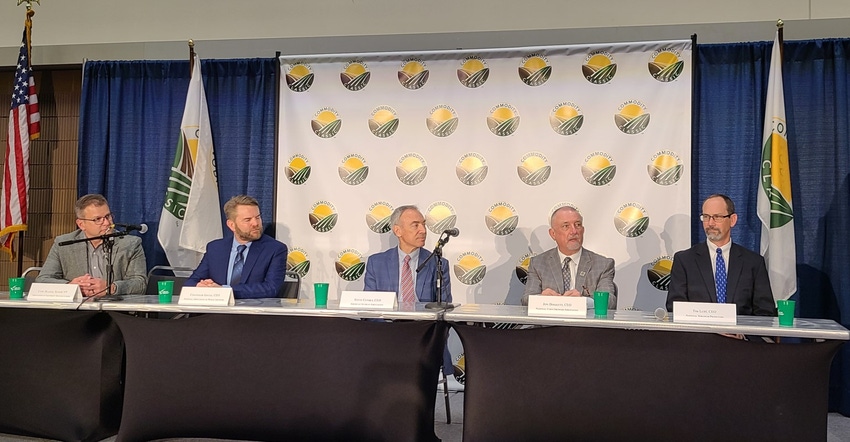
The commodity groups representing key agricultural commodities often find themselves in lockstep in advocating for farmers and facing the same issues. On the sidelines of the Commodity Classic, the joint meeting of the National Corn Growers Association, American Soybean Association, National Association of Wheat Growers and the National Sorghum Producers, chief executive officers of each of the groups outlined some of the key priorities and concerns heading into 2022.
A common concern among all the leaders is the rising input costs, most notably fertilizer prices. Jon Doggett, NCGA CEO, says the biggest issue he’s hearing from farmers is the prices farmers have paid for fertilizer and continued concerns about future fertilizer supplies.
“We are very concerned about fertilizer markets,” Doggett says. The corn growers have been outspoken on their requests for fertilizer companies to drop their request for countervailing duties on fertilizer imports. He also notes that some of the ongoing run-up in fertilizer prices bears some investigation.
Imagine what a nightmare producers would be in today if the market was at $3 corn, instead of $7, he says. “We know there are issues with supply chain, but let’s not make it worse,” Doggett adds.
When the world is going to need more corn and wheat, this unsettledness and uncertainty around major inputs including fertilizer and glyphosate continues to have producers on edge, “just at the moment when the world is going to need us to maximize our production,” he continues.
Tim Lust, NSP CEO, explains the many issues in obtaining fertilizer and chemicals creates a perfect storm and reveals many weaknesses in the supply chain. “I don’t think this is going to go away,” Lust warns of continued challenges in obtaining inputs. He says that although sorghum producers don’t have as many inputs as other commodities, even the trucking shortages alone can hinder the crop inputs from making it to the farm gate.
Many groups expressed concerns over potential changes by this administration in crop protection product allowable levels. “We’re very much concerned about how this administration makes decisions about crop protection tools,” says Steve Censky, ASA CEO. He says ASA’s message is to encourage EPA to not take away the available tools to producers today. “Herbicide costs and availability are already low. EPA can’t be taking those tools away from farmers, as it will just add to their issues.”
Farm bill updates
The rising input costs are also becoming a common thread of discussion amongst commodity groups as they look to develop their policy requests in anticipation of the 2023 Farm Bill discussion. Crop insurance remains paramount, but there’s growing discussion on updating reference prices to reflect rising production costs and what updates to base acres could bring to different crop sectors.
Depending on the elections this fall, Chandler Goule, NAWG CEO and president, says the House Agriculture Committee could have as many as 50% of its members new to the farm bill process. Goule says it will be important to “educate members on how to make informed decisions to support U.S. wheat growers and all farmers.”
NAWG hopes to maintain flexibilities between the Average Revenue Coverage and Price Loss Coverage, as well as utilizing the conservation title to reach the climate initiative goals.
ASA’s Cenksy says the low soybean reference price for PLC didn’t trigger when the China trade war sent soybean prices crashing. Base acres are also a concern as some young, beginning farmers may be farming ground that may have only 10-15% base because it previously was in alfalfa or pasture.
ASA has already conducted 12 listening sessions, with five of those focused on specific farm bill titles and the remaining seven based on regions. This feedback also confirms support for voluntary, incentive-based conservation programs.
Goule says he does not expect a marker bill outlining priorities from ag committee leadership until after the November 2022 elections. Cenksy says he is expecting field hearings from the House and Senate potentially yet this year, but the “actual brass tacks work on crafting the bill won’t start until 2023.”
Will it cross the finish line before it expires at the end of 2023? Cenksy and the others are hopeful. He says, “Hope springs eternal.”
Trade focus
Turning to trade, Goule notes that China has not lived up to its World Trade Organization requirements following a case brought by the U.S. challenging its domestic support for wheat and rice. “China is still out of compliance, and they did not appeal,” he says.
In addition, although China did increase its market purchases under the Phase One Agreement, it is still 20% short of fulfilling that commitment. “We still have a lot of outstanding issues that need to be resolved,” Goule says of the relationship with China.
Cenksy says even as the administration manages tough issues with China, ASA and others want to make sure ag exports keep flowing.
“Even as we engage over very large, massive geopolitical issues, China needs our soybeans,” he says. China is the largest soybean market in the world and imports as many soybeans as the rest of the world combine.
About the Author(s)
You May Also Like






